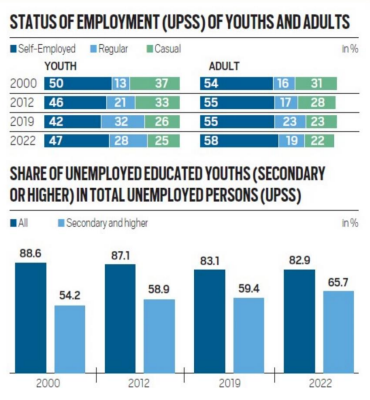Ahmedabad
(Head Office)Address : 506, 3rd EYE THREE (III), Opp. Induben Khakhrawala, Girish Cold Drink Cross Road, CG Road, Navrangpura, Ahmedabad, 380009.
Mobile : 8469231587 / 9586028957
Telephone : 079-40098991
E-mail: dics.upsc@gmail.com

Context: The recently published India Employment Report 2024, the third installment in a series conducted by the Institute for Human Development in collaboration with the International Labour Organization (ILO), delves into the challenges surrounding youth employment amidst Indias shifting economic, labor market, educational, and skills
landscapes over the past twenty years.
Key Findings:
• India’s Labour Market Conditions:
o Recent years have seen paradoxical improvements in labour market indicators in India, following long-term deterioration from 2000-2019, which coincided with periods of economic distress.
o Key concerns include:
o Reversal of the slow transition to non-farm employment.
o Increase in self-employment and unpaid family work, particularly among women.
o Lower quality youth employment compared to adults.
o Stagnant or declining wages and earnings.
• Unemployment Rates:
o The unemployment rate declined between 2019-2022 after a rise from 2000-2019.
o Bihar, Odisha, Jharkhand, and UP consistently rank at the bottom of the employment condition index, while Delhi, Himachal Pradesh, Telangana, Uttarakhand, and Gujarat remain at the top.
• Employment Quality:
o Informal employment has increased, with around half of formal sector jobs being informal.
o Self-employment remains the primary source of work, rising to 55.8% in 2022 from around 52% in 2000-2019.
o Regular employment, associated with better job quality, declined to 21.5% in 2022 after reaching 23.8% in 2019 from 14.2% in 2000.
o Casual employment, linked to poorer job quality, decreased to 22.7% in 2022 from 33.3% in 2000.
• Women’s Labor Force Participation:
o Indias female labour force participation rate (LFPR) remains among the worlds lowest at 32.8% in 2022, 2.3 times lower than mens.
o Female LFPR declined by 14.4 percentage points from 2000-2019 but rose by 8.3 points from 2019-2022.
o Indias female LFPR in 2022 was lower than the global average of 47.3% but higher than South Asias 24.8%.
• Sectoral Employment Shifts:
o The share of agriculture in total employment declined from 60% in 2000 to around 42% in 2019, largely absorbed by construction and services.
o This slow transition stagnated or reversed since 2018-19.
o Manufacturings share of employment has remained around 12-14%
• Youth Employment:
o Youth employment and underemployment increased from 2000-2019 but decreased during the pandemic.
o Unemployment is notably higher among educated youth, especially graduates.
o The unemployment rate for secondary educated youth was 18.4% in 2022 compared to 3.4% for those with no literacy skills.
o Graduate unemployment stood at 29.1% overall, with higher rates for women (34.5%) compared to men (26.4%).
o Educated youth unemployment rose from 23.9% in 2000 to 30.8% in 2019 before declining to 18.4% in 2022.

Address : 506, 3rd EYE THREE (III), Opp. Induben Khakhrawala, Girish Cold Drink Cross Road, CG Road, Navrangpura, Ahmedabad, 380009.
Mobile : 8469231587 / 9586028957
Telephone : 079-40098991
E-mail: dics.upsc@gmail.com
Address: A-306, The Landmark, Urjanagar-1, Opp. Spicy Street, Kudasan – Por Road, Kudasan, Gandhinagar – 382421
Mobile : 9723832444 / 9723932444
E-mail: dics.gnagar@gmail.com
Address: 2nd Floor, 9 Shivali Society, L&T Circle, opp. Ratri Bazar, Karelibaugh, Vadodara, 390018
Mobile : 9725692037 / 9725692054
E-mail: dics.vadodara@gmail.com
Address: 403, Raj Victoria, Opp. Pal Walkway, Near Galaxy Circle, Pal, Surat-394510
Mobile : 8401031583 / 8401031587
E-mail: dics.surat@gmail.com
Address: 303,305 K 158 Complex Above Magson, Sindhubhavan Road Ahmedabad-380059
Mobile : 9974751177 / 8469231587
E-mail: dicssbr@gmail.com
Address: 57/17, 2nd Floor, Old Rajinder Nagar Market, Bada Bazaar Marg, Delhi-60
Mobile : 9104830862 / 9104830865
E-mail: dics.newdelhi@gmail.com